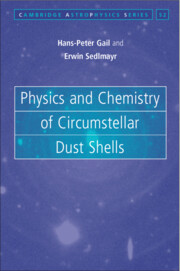Book contents
- Frontmatter
- Contents
- Preface
- Part I Setting the Stage
- Part II Theoretical Description of Circumstellar Dust Shells
- Part III Applications
- 15 Modeling of Circumstellar Dust Shells
- 16 Miras and Long-Period Variables
- 17 Mass-Loss Formulas
- 18 R Coronae Borealis Stars
- Part IV Appendices
- Bibliography
- Index
- Miscellaneous Endmatter
15 - Modeling of Circumstellar Dust Shells
from Part III - Applications
Published online by Cambridge University Press: 18 December 2013
- Frontmatter
- Contents
- Preface
- Part I Setting the Stage
- Part II Theoretical Description of Circumstellar Dust Shells
- Part III Applications
- 15 Modeling of Circumstellar Dust Shells
- 16 Miras and Long-Period Variables
- 17 Mass-Loss Formulas
- 18 R Coronae Borealis Stars
- Part IV Appendices
- Bibliography
- Index
- Miscellaneous Endmatter
Summary
Basic Ingredients for Reliable Shell Modeling
Any attempt at a reliable modeling of a circumstellar dust shell has to rely on the mutual coupling of matter and radiation, where with respect to the matter one has to distinguish between gas and dust, making such an object, in principle, a coupled three-component system: gas, dust, and radiation, which requires an adequate treatment of each of the components and a consistent three-component approach to the system as a whole. In Part II, various approximations were outlined that were appropriate at different levels of approach for treating the gas, the dust, and the radiation complex, respectively.
In those cases where the gas and the dust components are dynamically tightly coupled (see Section 3.5.6), a one-fluid description for the matter is justified with regard to the hydrodynamic part of the problem. The same holds for the thermodynamical description, if the collisional coupling between the various material components is efficient enough to establish local thermodynamic equilibrium (LTE) such that there results a common temperature shared by all material components. Thus, in many circumstellar dust shells, conditions prevail where a one-component description of both the dynamics and the energetics of the matter is appropriate.
- Type
- Chapter
- Information
- Physics and Chemistry of Circumstellar Dust Shells , pp. 459 - 520Publisher: Cambridge University PressPrint publication year: 2013

